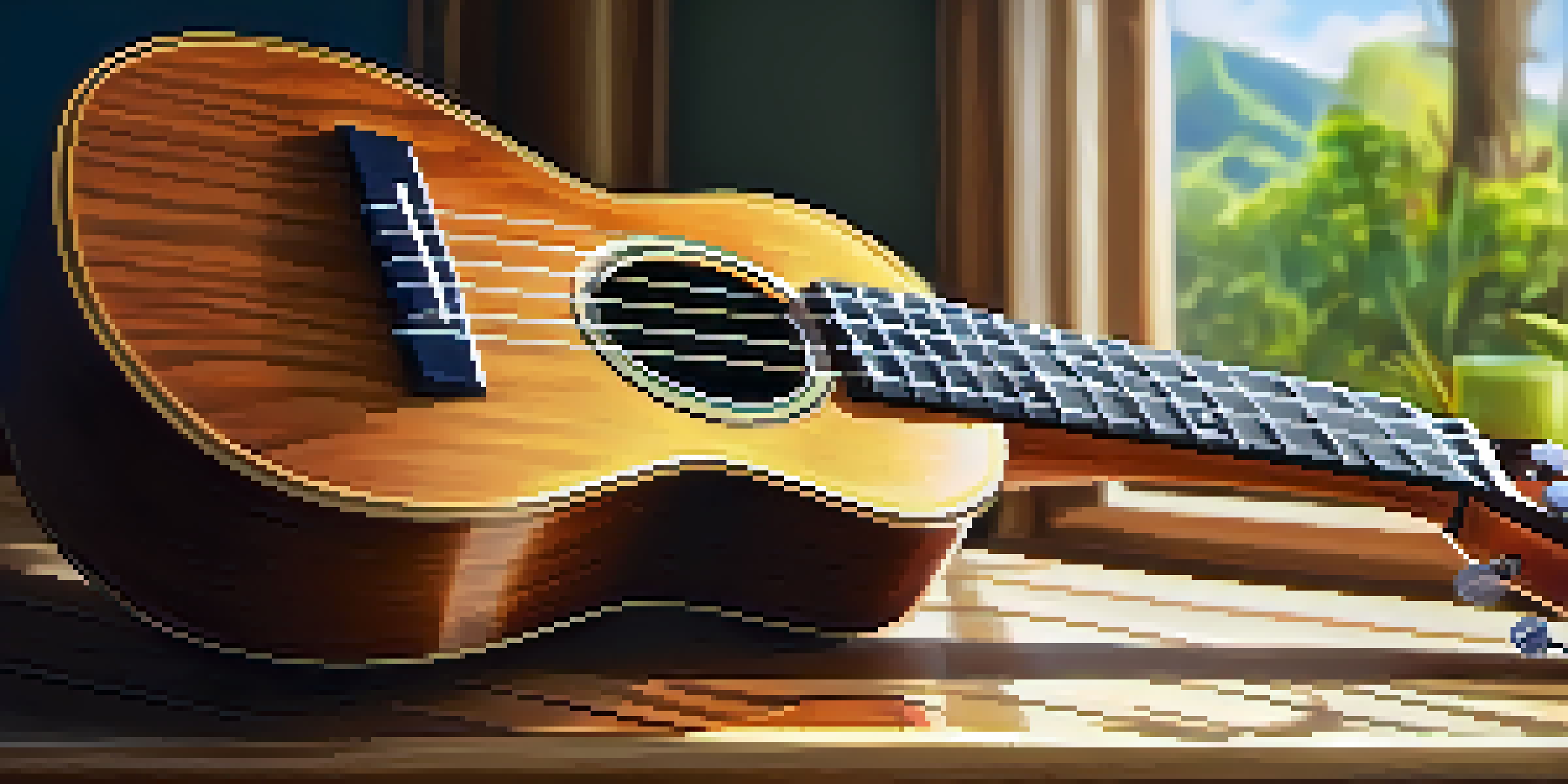Understanding Resonance and Its Role in Ukulele Sound

What is Resonance and Why Does It Matter?
Resonance is a fascinating phenomenon that occurs when an object vibrates at its natural frequency. This vibration amplifies sound, making it richer and fuller. In the context of musical instruments like the ukulele, resonance plays a crucial role in how we perceive sound quality. Without resonance, the ukulele would sound weak and less appealing.
Music is the shorthand of emotion.
Think of resonance like a room filled with echoes; the right frequencies bounce around, creating a beautiful, layered sound. When you strum a ukulele, the vibrations from the strings travel through the body of the instrument, causing it to resonate. This interaction between the strings and the body is what gives the ukulele its unique tonal characteristics.
Understanding resonance helps musicians appreciate their instrument's capabilities. A well-crafted ukulele is designed to optimize resonance, allowing for a brighter sound that carries well. This makes learning about resonance not just an academic exercise, but a practical way to enhance your musical experience.
The Anatomy of a Ukulele: How Resonance is Achieved
To grasp how resonance works in a ukulele, it's essential to understand its anatomy. The key components include the body, neck, and strings. The body, typically made from wood, is hollow and acts as a resonating chamber. When strings are plucked, they vibrate, and these vibrations transfer into the body, causing it to resonate and produce sound.

The size and shape of the ukulele's body significantly influence its sound. A larger body generally creates a deeper tone, while a smaller body results in a brighter, more cheerful sound. Different woods also contribute to resonance; for instance, mahogany provides warmth, while spruce delivers clarity. Each combination creates a unique sound profile.
Resonance Enhances Sound Quality
Resonance amplifies sound in instruments like the ukulele, enriching its tonal quality and making it more appealing.
This understanding allows players to choose the right ukulele for their style. Whether you're strumming soft melodies or performing lively tunes, knowing how resonance is achieved can guide your selection. Ultimately, the anatomy of the ukulele is not just about construction; it's about crafting the sound you want to create.
How String Tension Affects Resonance
String tension is a vital element in the resonance of a ukulele. When you tighten or loosen the strings, you alter their frequency, which directly impacts the sound produced. Higher tension results in a brighter, sharper tone, while lower tension yields a softer sound. This is why tuning is so important for musicians.
The beautiful thing about learning is that no one can take it away from you.
Imagine tuning your ukulele like stretching a rubber band; the more you stretch it, the higher the pitch. Each string's tension interacts with the body of the ukulele, amplifying certain frequencies and dampening others. This delicate balance is what allows musicians to express themselves through different playing styles.
Thus, understanding how string tension affects resonance can help you achieve the desired sound. Whether you're aiming for a mellow strum or a vibrant pluck, adjusting the tension can make all the difference. This knowledge empowers players to explore various tonal possibilities, enhancing their musical journey.
The Role of Wood Selection in Resonance
The type of wood used in a ukulele significantly affects its resonance and overall sound. Different woods resonate at different frequencies, which can enhance or alter the instrument's tonal qualities. Common woods like mahogany, koa, and spruce each contribute unique characteristics to the ukulele's sound.
For example, koa is known for its warm, rich tones, while spruce offers a bright and clear sound. When you strum a ukulele made from these materials, you'll notice how the wood influences the resonance and projection. It's like choosing the right ingredients for a recipe; the outcome depends on the quality and type of each component.
Wood Selection Affects Tone
The type of wood used in a ukulele significantly influences its resonance and overall sound characteristics.
As a player, experimenting with various woods can reveal a world of sonic possibilities. Understanding how wood selection impacts resonance allows you to find an instrument that matches your personal style and sound preferences. This knowledge not only enhances your playing experience but also deepens your connection to the instrument.
How Playing Technique Influences Resonance
Your playing technique can greatly influence the resonance of your ukulele. Techniques such as strumming, fingerpicking, or using a pick all produce different sounds due to the way they interact with the strings and body of the instrument. Each method creates varying vibrations, which can either enhance or dampen resonance.
For instance, a gentle fingerpicking style allows for more subtle vibrations to resonate through the body compared to a hard strum. Think of it like tapping a glass; a light tap produces a sweet, ringing tone, while a heavy hit may create a dull sound. This illustrates how nuanced your technique can be in shaping the overall sound.
By exploring different playing techniques, you can discover new ways to coax out the ukulele's rich resonance. Whether you're a beginner or an experienced player, experimenting with your approach can lead to exciting new sounds. It’s all about finding what resonates with you.
The Impact of Environment on Ukulele Resonance
The environment in which you play can significantly affect your ukulele's resonance. Factors such as room size, acoustics, and even furniture can alter how sound waves travel and bounce around. For example, playing in a small, carpeted room may dampen sound compared to a larger space with hard surfaces that amplify it.
Consider how musicians often seek out unique venues for performances; the acoustics of a space can enhance their sound. Playing in an open area may allow your ukulele to project more, while a closed space may create a more intimate experience. Understanding these dynamics can help you choose where to practice or perform.
Playing Technique Shapes Sound
Different playing techniques, such as strumming or fingerpicking, impact the resonance of a ukulele, affecting the resulting sound.
Ultimately, being mindful of your environment can enhance your ukulele experience. Experimenting with different locations can reveal how the setting impacts resonance, allowing you to adapt your playing style accordingly. This awareness not only improves sound quality but also enriches your overall musical journey.
Finding Your Unique Sound Through Resonance
Understanding resonance is a key step in finding your unique sound as a ukulele player. By exploring how various factors, from wood selection to playing techniques, impact resonance, you can tailor your approach to suit your musical style. This journey of discovery is what makes playing the ukulele so rewarding.
As you experiment with different ukuleles and techniques, you'll begin to notice what resonates with you personally. Whether you gravitate toward a warm, mellow sound or a bright, cheerful tone, this exploration will guide you to your signature style. It's much like finding your voice in a conversation—your sound becomes a reflection of who you are.

In conclusion, embracing the concept of resonance allows you to deepen your connection with your instrument. The more you understand how resonance works, the more you can unlock the full potential of your ukulele. So go ahead, strum, pluck, and explore; your unique sound is waiting to be discovered.